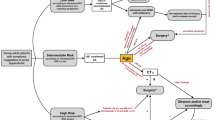Abstract
The management of patients with suspected post laparotomy intraabdominal sepsis poses a major therapeutic challenge to clinicians. The mortality is high and the optimal interventional modality remains ill-defined.
We define the incidence, diagnostic methodology, pre-and postoperative findings and outcome of patients going from the intensive care unit for a repeat laparotomy in search of abdominal sepsis over a one year period.
Fifteen patients were included with an overall mortality of 60 per cent. In 6 cases more than one relaparotomy was performed with a mortality of 50 per cent. Sepsis was found in 14 of the 15 cases with a mortality of 57 per cent and the patient with a normal relaparotomy died. The primary surgery was elective in 26 per cent of cases and the mortality was 50 per cent. All the non-survivors required mechanical ventilation, inotropic support and continuous veno-veno haemodialysis while the survivors required less organ support. Radiological assessment (ultrasound scan and CT scan) were no better at predicting an abnormal relaparotomy than clinical assessment.
Higher mortality rates were associated with increasing age and multi-system organ failure (p< 0.05).
Similar content being viewed by others
References
Bohmen, J., Bonlager, M., Meakins, J. Prognosis and generalized peritonitis. Arch. Surg. 1983; 118: 285–288.
Hinsdale, J. G., Jaffe, B. M. Re-operation for intraabdominal sepsis. Ann. Surg. 1984; 199: 31–36.
Delinger, E., Wertz, M., Meakins, J. Surgical infection stratification for intra-abdominal infection: multi-center trial. Arch. Surg. 1985; 120: 21–29.
Koehler, P., Knochil, Q. Computed tomography in the evaluation of abdominal abcesses. Am. J. Surg. 1980; 110: 1089–1094.
Posteraro, R. H., Ravin, C. Magnetic Resonance Imaging in critically ill patients. Crit. Care Med. 1987; 9: 273–284.
Christou, N. V., Barie, P. S. Surgical infection society intraabdominal infection study. Arch. Surg. 1993; 128: 193–199.
Polk, H. C. Jr., Fry, D. E. Radical peritoneal debridement for established peritonotis: the results of a prospective randomized controlled trial. Ann. Surg. 1980; 192: 350–355.
Kinney, E. V., Polk, H. C. Jr. Open treatment of peritonitis: an argument against. Adv. Surg. 1987; 21: 19–28.
Maddaus, M. A., Simmons, R. L. Leave the abdomen open for peritonitis: yes, no, maybe? Adv. Surg. 1987; 21: 1–12.
Pusajo, J. E, Bumaschny, E. Postoperative intra-abdominal sepsis requiring reoperation. Value of a predictive index. Arch. Surg. 1993; 128: 218–223.
Bunt, T. J. Urgent relaparotomy: the high risk no choice operation. Surgery. 1985; 98 No. 3: 555–560.
Author information
Authors and Affiliations
Rights and permissions
About this article
Cite this article
McCrory, C., Crowley, K. Is repeat laparotomy of value in patients with suspected intra-abdominal sepsis in the intensive care unit?. I.J.M.S. 166, 88–91 (1997). https://doi.org/10.1007/BF02944195
Issue Date:
DOI: https://doi.org/10.1007/BF02944195




